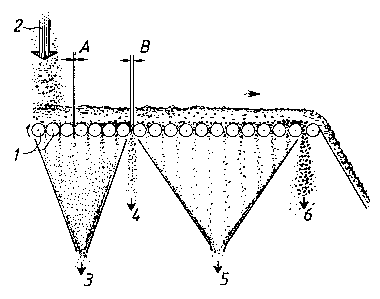Une partie des informations de ce site Web a été fournie par des sources externes. Le gouvernement du Canada n'assume aucune responsabilité concernant la précision, l'actualité ou la fiabilité des informations fournies par les sources externes. Les utilisateurs qui désirent employer cette information devraient consulter directement la source des informations. Le contenu fourni par les sources externes n'est pas assujetti aux exigences sur les langues officielles, la protection des renseignements personnels et l'accessibilité.
L'apparition de différences dans le texte et l'image des Revendications et de l'Abrégé dépend du moment auquel le document est publié. Les textes des Revendications et de l'Abrégé sont affichés :
| (12) Brevet: | (11) CA 2168898 |
|---|---|
| (54) Titre français: | ELIMINER LES IMPURETES DES MATERIAUX PULVERISES OU DECHIQUETES |
| (54) Titre anglais: | REMOVING IMPURITIES FROM PULVERIZED OR CHIPPED MATERIAL |
| Statut: | Durée expirée - au-delà du délai suivant l'octroi |
| (51) Classification internationale des brevets (CIB): |
|
|---|---|
| (72) Inventeurs : |
|
| (73) Titulaires : |
|
| (71) Demandeurs : |
|
| (74) Agent: | MARKS & CLERK |
| (74) Co-agent: | |
| (45) Délivré: | 2006-05-16 |
| (22) Date de dépôt: | 1996-02-06 |
| (41) Mise à la disponibilité du public: | 1996-08-16 |
| Requête d'examen: | 2003-01-06 |
| Licence disponible: | S.O. |
| Cédé au domaine public: | S.O. |
| (25) Langue des documents déposés: | Anglais |
| Traité de coopération en matière de brevets (PCT): | Non |
|---|
| (30) Données de priorité de la demande: | ||||||
|---|---|---|---|---|---|---|
|
L'invention concerne une méthode et un appareil pour tamiser des matériaux pulvérisés ou déchiquetés, tels que des fibres ou des copeaux de bois, pour les rendre libres de toute impureté. Les matériaux à tamiser sont apportés à un ensemble de rouleaux formé par plusieurs rouleaux adjacents, essentiellement parallèles (1) et sont amenés à un mouvement avantageux à l'aide des dits rouleaux (1), dans lequel les particules de matériau de la densité la plus élevée dérivent vers le bas, au plus près des surfaces des rouleaux et les fractions de matériau les plus proches des surfaces des rouleaux peuvent s'échapper des rouleaux par un espace (B) dont la largeur est essentiellement plus grande que la largeur de l'espace (A) de la paire de rouleaux précédents.
The invention relates to a method and apparatus for screening pulverized or chip material, such as fibers or wood chips, free from impurities. The material to be screened is fed onto a roil set formed by a number of adjacent, essentially parallel rolls (1) and is brought to an advantageous movement with the help of said rolls (1), whereby material particles of highest density drift downward closest to the surfaces of the rolls and that the material fraction closest to the roll surfaces can escape the rolls via a gap (B) a width essentially larger than the gap width (A) of the preceding roll pairs.
Note : Les revendications sont présentées dans la langue officielle dans laquelle elles ont été soumises.
Note : Les descriptions sont présentées dans la langue officielle dans laquelle elles ont été soumises.

2024-08-01 : Dans le cadre de la transition vers les Brevets de nouvelle génération (BNG), la base de données sur les brevets canadiens (BDBC) contient désormais un Historique d'événement plus détaillé, qui reproduit le Journal des événements de notre nouvelle solution interne.
Veuillez noter que les événements débutant par « Inactive : » se réfèrent à des événements qui ne sont plus utilisés dans notre nouvelle solution interne.
Pour une meilleure compréhension de l'état de la demande ou brevet qui figure sur cette page, la rubrique Mise en garde , et les descriptions de Brevet , Historique d'événement , Taxes périodiques et Historique des paiements devraient être consultées.
| Description | Date |
|---|---|
| Inactive : Périmé (brevet - nouvelle loi) | 2016-02-06 |
| Inactive : Lettre officielle | 2012-04-04 |
| Inactive : Renversement de l'état sera réputé périmé | 2012-03-28 |
| Lettre envoyée | 2012-02-06 |
| Lettre envoyée | 2009-10-19 |
| Lettre envoyée | 2009-10-19 |
| Lettre envoyée | 2009-10-19 |
| Inactive : Correspondance - Transfert | 2009-08-27 |
| Accordé par délivrance | 2006-05-16 |
| Inactive : Page couverture publiée | 2006-05-15 |
| Inactive : CIB de MCD | 2006-03-12 |
| Inactive : CIB de MCD | 2006-03-12 |
| Inactive : CIB de MCD | 2006-03-12 |
| Préoctroi | 2006-02-27 |
| Inactive : Taxe finale reçue | 2006-02-27 |
| Lettre envoyée | 2005-11-02 |
| Un avis d'acceptation est envoyé | 2005-11-02 |
| Un avis d'acceptation est envoyé | 2005-11-02 |
| Inactive : Approuvée aux fins d'acceptation (AFA) | 2005-08-08 |
| Modification reçue - modification volontaire | 2005-06-27 |
| Inactive : Dem. de l'examinateur par.30(2) Règles | 2004-12-30 |
| Inactive : Renseign. sur l'état - Complets dès date d'ent. journ. | 2003-02-21 |
| Lettre envoyée | 2003-02-21 |
| Inactive : Dem. traitée sur TS dès date d'ent. journal | 2003-02-21 |
| Toutes les exigences pour l'examen - jugée conforme | 2003-01-06 |
| Exigences pour une requête d'examen - jugée conforme | 2003-01-06 |
| Demande publiée (accessible au public) | 1996-08-16 |
Il n'y a pas d'historique d'abandonnement
Le dernier paiement a été reçu le 2006-01-23
Avis : Si le paiement en totalité n'a pas été reçu au plus tard à la date indiquée, une taxe supplémentaire peut être imposée, soit une des taxes suivantes :
Veuillez vous référer à la page web des taxes sur les brevets de l'OPIC pour voir tous les montants actuels des taxes.
Les titulaires actuels et antérieures au dossier sont affichés en ordre alphabétique.
| Titulaires actuels au dossier |
|---|
| SUNDS DEFIBRATOR LOVIISA OY |
| DIEFFENBACHER PANELBOARD OY |
| Titulaires antérieures au dossier |
|---|
| AARNE LAATIKAINEN |